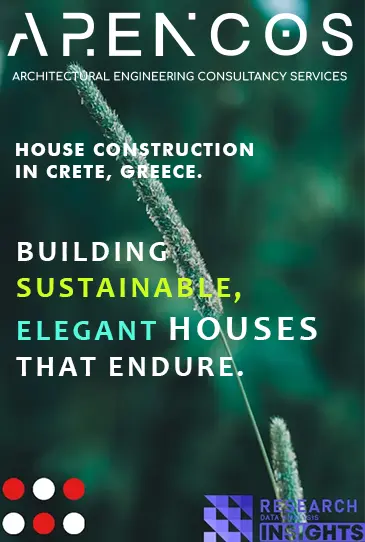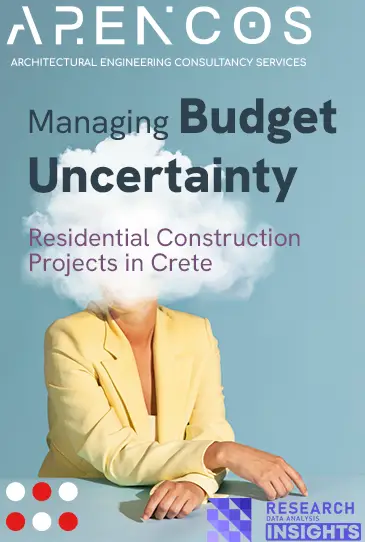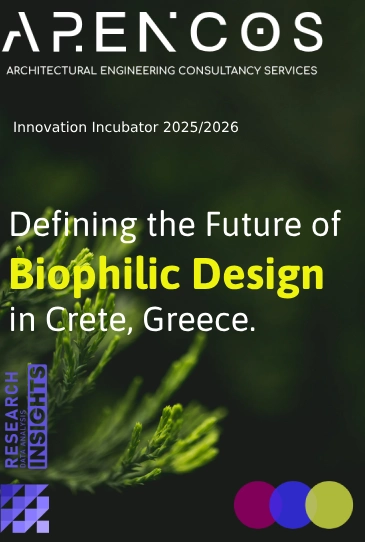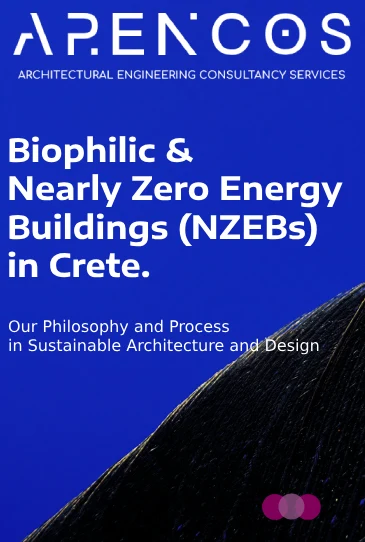Designing and Building Houses in Crete with Local Materials.
Utilizing local materials not only supports the local economy and craftsmen but also enhances the cultural and architectural identity of the community. Additionally, these materials typically have lower embodied energy, contributing to energy efficiency and sustainability in construction practices.
Benefits of building houses with locally available materials.
How does the use of locally available materials in house construction contribute to environmental sustainability? What are the economic advantages for communities when houses are built using locally sourced materials?
Incorporating locally-sourced materials and methods in the residential designing and building processes, is not only an environmentally friendly decision but also a way to create a high aesthetic, yet authentically sustainable living space.
This is because local materials like stone, wood, gravel, granite etc require less transportation and complex supply chain routes, which in turn reduces the amount of fuel consumed in the transportation process and the associated emissions.
Additionally, when the construction materials are sourced locally are often much more sustainable, as they are typically sourced from renewable resources, require less packaging and are produced using environmentally friendly methods.
Furthermore, local materials originating from the island of Crete or in other locations around Greece, are often more durable and long-lasting, which means that they require less maintenance and replacement over time. This can further reduce the environmental impact of your home.
Less Packaging & Transportation Costs
Incorporating locally sourced materials and methods in the residential designing and building processes is not only an environmentally friendly decision but also a way to create a high aesthetic, yet authentically sustainable living space.
This is because local materials like stone, wood, gravel, granite etc require less transportation and complex supply chain routes, which in turn reduces the amount of fuel consumed in the transportation process and the associated emissions.
Additionally, when the construction materials are sourced locally are often much more sustainable, as they are typically sourced from renewable resources, require less packaging and are produced using environmentally friendly methods.
Cost Efficiency
Furthermore, local materials originating from the island of Crete or in other locations around Greece, are often more durable and long-lasting, which means that they require less maintenance and replacement over time. This can further reduce the environmental impact of your home.
In addition to the environmental benefits, when designing and building houses in Crete with local materials, there are economic advantages also.
Local materials are often more affordable than imported alternatives, as they do not incur the same transportation and import costs. This can result in significantly lower construction and development costs for the project owners, particularly when it comes to strict budget projects or small-scale residential properties. Moreover, by supporting local businesses and suppliers in Crete, you can contribute to the stimulation and enforcement of the local economy.
High Aesthetic
The use of locally sourced materials in residential design and development can also have aesthetic benefits. Each element in the interior or exterior design can serve as a reminder of the area’s history and the diverse tapestry of the Cretan heritage, making any residential project a true reflection of architectural uniqueness.
Local materials often have unique characteristics that can add a sense of Cretan authenticity and character to any residential project. Integrating elements representing the Cretan background brings a deeply personal and meaningful dimension to the living space of any house.
Promoting Wellness & Belonging
Sustainability is an essential practice in our modern societies, as it focuses on following practices and habits of living to reduce and mitigate the environmental impact.
Finally, incorporating locally-sourced materials can also contribute to a sense of well-being and belonging and last but not least, reinforce the connectedness to the local community.
This can help to foster a sense of pride in your local community and encourage a greater appreciation for the local flora and fauna and the resources of the local ecosystem.
Total Architecture & Biophilic Design.
We have developed our sustainable residential construction approach, from over 25 years of experience, starting from a focus on Biophilic Design and Total Architecture to the more holistic approach we take today. Passive House design principles and considerations are now an integral part of our decision-making.


Author: Stavros Thomas
Developer strength and income resilience will be the focus as the recession hits the demand.
Sustainable Living in Chania, Crete
Embracing Local Materials in Home Construction
Integrating locally sourced materials into the architectural design of a residential property is not only an environmentally friendly approach but also a way to create a unique and authentic space that matters. As residential structures continue to rise and building areas expand, the demand for more sustainable and eco-friendly construction materials has become paramount.
Particularly in Crete, in hot and arid regions such as Apokoronas, Akrotiri, and Kisamos, traditional building materials like adobe and rammed earth provide excellent insulation and thermal mass, helping to keep buildings cool during the day and warm at night.
In contrast, materials such as concrete and steel, commonly used in modern construction in Crete, can contribute to the urban heat island effect and increase energy consumption for cooling and heating—especially if those properties are used as short-term rentals.
By using materials naturally suited to Crete's local climate, property owners can reduce their reliance on energy-intensive heating and cooling systems, leading to lower energy bills and a reduced carbon footprint.
One example of this approach can be seen in the growing popularity of locally sourced stone in residential project construction. Stone is a durable and low-maintenance material that can be used for a variety of purposes, from exterior cladding to interior flooring and countertops.
Traditional Building Materials and Design
Traditional building design strategies in the Mediterranean demonstrate a range of passive solar design strategies and techniques to bring environmental comfort to occupants.
In a traditional Cyprus house, for example, the solarium and courtyard function as climate modifiers (Serghides, 2010). The solarium is an internal space, adjoining the courtyard. Its south elevation opens to facilitate the seasonal indoor-outdoor flows of daily activities (e.g., cooking, washing, eating and so on). The south-facing overhang of the solarium is designed to allow winter sunlight to penetrate deep into the space.
The south-facing courtyard acts as a sun space. Both the solarium and courtyard are made of high thermal mass materials, such as stone paving, adobe walls, stone staircase and pools, to create a more pleasant microclimate along the long front facade of the house. The front wall of the courtyard also acts as buffer to cold winds. During summer, planting and soft-scape in the courtyard provide shade and a cool microclimate in front of the house.
The pool and fountain in the courtyard provide evaporative cooling. The designs of arches, overhangs and openings on the wall facing the courtyard help channel summer breezes into the house. Openings are small on the east- and west- facing walls to avoid hot summer sun.
Thermal mass materials in the courtyard and solarium absorb the heat during the day and release back to the ambient air at night effectively due to the large diurnal fluctuations of temperature in the hot arid Mediterranean region.
According to UpData, the following are the most important parameters to consider when designing and building houses with local materials:
- Adaptability: Flexibility in Design
- Customization to Site Conditions
- Integration with Modern Construction Techniques
- Versatility in Design
Sustainable Construction Solutions
Cost-Effectiveness - Innovation and Creativity
Environmental Benefits - Conservation of Natural Resources
- Waste Reduction and Recycling
- Reduced Carbon Footprint
- Energy Efficiency
- Enhanced Indoor Air Quality
- Resilience to Climate Change
- Promotion of Sustainable Practices
The comprehensive benefits of using local materials in construction: The most important factors to consider towards sustainable construction:
- Local Materials: A Sustainable Choice
- Resource Availability and Abundance
- Low Environmental Impact
- Affordability and Cost-Effectiveness
- Preservation of the Local Economy
- Cultural Preservation and Aesthetics
- Reduced Waste Generation
- Ecological Balance and Biodiversity
- Thermal Insulation
- Moisture Regulation
- Passive Design Strategies
- Thermal Mass
- Sustainable Cooling Strategies
- Resilience to Extreme Weather
- Connection to Nature and Biophilic Design
Eco House Pricing Crete
Passive House vs. Standard House Cost Comparison
Suppose you are building an eco-house in Crete, Greece, by implementing and integrating eco-friendly materials, energy-efficient systems and appliances, and natural ventilation systems that reduce the need for artificial heating and cooling and ensure thermal comfort.
In that case, you can establish a space that is conducive to physical and mental well-being and ecologically resilient.
Here, we examine a 186.000 square meters new home built in Apokoronas, Chania in 2024. Compare building a Passive House, the highest energy efficiency standard for residential properties globally, with a regular house.
| ECO-HOUSE (€) | REGULAR HOUSE | |
| Building Cost | 330.000 | 300.000 |
| Heating Cost | 7.000 | 18.000 |
| Total Construction Cost | 337.000 | 318.000 |
| Annual Energy Bill | 450 | 1.880 |
Our analysis shows that eco-houses only cost about 6-8% more than traditional residential properties.
Similarly, according to our experience in Passive House Projects in Crete, a passive house typically costs 5-10% more than a typical residential house in Crete, Greece.
Is it Worthwhile?
In contrast with a “normal residential property“, the cost burden usually is considerably less for the construction of a certified eco-house, even if energy costs remain high in the future. Therefore eco-houses tend to be economically attractive and technically feasible – even though the cost benefits are not as enormously high as sometimes promised.

Understanding the Process
- Building a House in Crete: The Initial Steps
- Dealing with Construction Permits
- Choosing and Working with Builders
- Understanding the Design-Build Process
- Factors Affecting Construction Cost
- How Much Does it Cost to Build a House in Chania,
Latest Articles
Eco House Pricing in Crete, Greece.
How much does designing and building a sustainable house in Crete, Greece cost? What is a normal price range?
Tracking Interest and Demand for Eco-Residential Projects in Crete, Greece.
How are sustainable and eco-friendly homes impacting property values in Crete, Greece? What challenges do property owners face when transitioning to sustainable and eco-friendly homes?
Planning and Design a Sustainable House in Chania.
A Paradigm Project in the area of Apokoronas.

ARENCOS
Sustainable Buildings in Crete
Let’s use the power of knowledge-sharing, critical thinking, and creativity to drive positive change towards a greener tomorrow in construction projects in Crete.
Inspired Spaces & Stories
House Construction in Crete: Building Sustainable, Elegant Houses that Endure.
House Construction in Crete: Building Sustainable Houses The Role of Strategic Design Residential construction in Crete is evolving beyond traditional methods toward a new paradigm
Managing Budget Uncertainty in Residential Construction Projects in Crete
Managing Budget Uncertainty in Residential Construction Projects in Crete Building momentum for 2026 and beyond. The landscape of residential construction projects in Crete is evol
Defining the Future of Biophilic Design in Crete
Biophilic Projects in Crete, Survey Biophilic Design in Residential Properties in Crete, Greece. Perhaps the most significant architectural design parameter today is the health and
Biophilic & Nearly Net-Zero Energy Buildings (NZEBs) in Crete: Our Philosophy
ARENCOS About this report At ARENCOS, we take our role seriously as one of Crete’s leading firms in sustainable architecture, biophilic design, passive house construction, and we
Chania Real Estate Investor Intentions Guide 2025
Key Insights & Market Outlook ARENCOS Chania Real Estate Investor Intentions Survey 2025. The ARENCOS Chania Real Estate Investor Intentions Survey 2025, conducted between Nove




